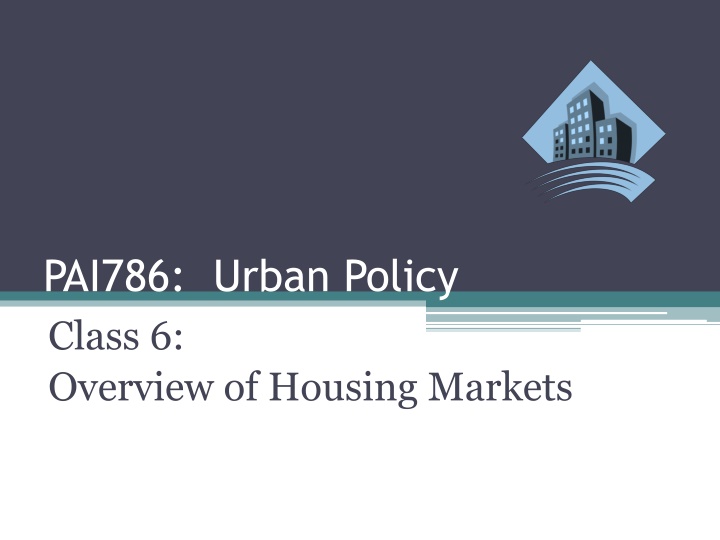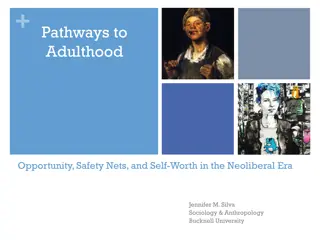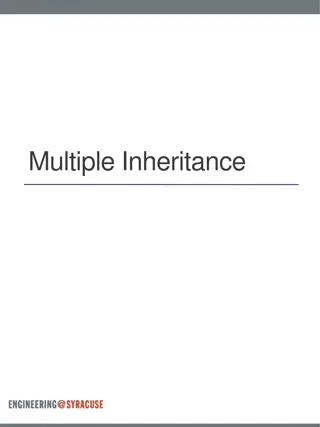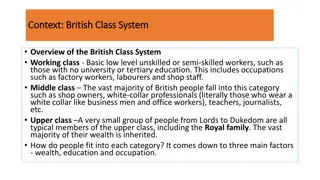
Overview of Urban Housing Markets: Key Concepts and Trends
Dive into the dynamic world of urban housing markets in this comprehensive overview. Explore topics such as housing demand, supply, landlord decisions, and the impact of regulations on market outcomes. Understand the demographics driving housing demand and the historical trends of homeownership versus renting. Gain insights into the supply of housing units, including existing units, new constructions, and the growing share of mobile and manufactured homes.
Download Presentation

Please find below an Image/Link to download the presentation.
The content on the website is provided AS IS for your information and personal use only. It may not be sold, licensed, or shared on other websites without obtaining consent from the author. If you encounter any issues during the download, it is possible that the publisher has removed the file from their server.
You are allowed to download the files provided on this website for personal or commercial use, subject to the condition that they are used lawfully. All files are the property of their respective owners.
The content on the website is provided AS IS for your information and personal use only. It may not be sold, licensed, or shared on other websites without obtaining consent from the author.
E N D
Presentation Transcript
PAI786: Urban Policy Class 6: Overview of Housing Markets
Urban Policy: Housing Markets Class Outline Housing Demand Housing Supply Landlord Decisions and the Neighborhood Effect Filtering
Urban Policy: Housing Markets The Housing Market Is Competitive There are many housing sellers, none of which dominates the market, even in a given urban area. But input markets may not be competitive. Regulations, such as building codes, may matter, that is, they may influence market outcomes.
Urban Policy: Housing Markets Housing Demand Housing demand is driven largely by demographics. But the link is not one-to-one; housing conditions affect household formation. The size and types of housing vary with economic conditions. The income elasticity of demand is positive and less than one.
Urban Policy: Housing Markets Most Households Are Homeowners There was a huge increase in homeownership after WWII. Over 2/3 of households are now homeowners. Renters are mostly in private, unsubsidized units. Public units = about 2% of rental units Subsidized units = about 4% of rental units
Urban Policy: Housing Markets Housing Supply Most housing is supplied by existing units. New units are also built, of course, but the number of constructed units varies widely over time. New units = about 2% of supply in a given year. For single-family houses, there are about 5 times as many sales of existing homes as of new ones.
Urban Policy: Housing Markets Housing Supply, Continued Many existing units are upgraded in any given year (more later). Mobile homes and manufactured housing are a growing share of the total, particularly in rural areas. Manufactured housing consists of sections constructed in a factory and assembled on a site; it is about 9% of new single-family housing starts.
Urban Policy: Housing Markets Housing Supply, Continued Housing supply activities are quite varied. They include: Downward conversion Maintenance Upgrading Upward conversion Nonresidential buildings are sometimes converted to housing (and vice versa).
Urban Policy: Housing Markets Housing Supply, Continued Housing maintenance/upgrading decisions are affected by neighborhood conditions. A landlord increases housing quality, H, until the marginal cost of improvement equals the marginal benefit. The marginal benefit is the price per unit of H, namely, P (or the expected P for upgrading decisions) An improvement in neighborhood amenities raises P, and hence raises housing maintenance or upgrading.
Urban Policy: Housing Markets Housing Supply, Continued The maintenance/upgrading decision MC P{A,u } P{A3,u } Neighborhood Improvement P{A2,u } Housing Improvement H0 H1 H2 H3 H = Housing Services Start of year End of year with no maintenance
Urban Policy: Housing Markets The Neighborhood Effect The link between neighborhood amenities and investment leads to an important externality: the neighborhood effect. One landlord s housing improvements raise neighborhood quality, but the landlord only considers the impact on his own profits. With this type of positive externality, landlords under-invest in housing, which implies that government subsidies have social benefits.
Urban Policy: Housing Markets The Neighborhood Effect, 2 The maintenance/upgrading decision MC P{A,u } H2 = private choice H3 = socially optimal choice Marginal Social Benefit P{A2,u }+NE Marginal Private Benefit P{A2,u } H0 H1 H2 H3 H = Housing Services Start of year End of year with no maintenance
Urban Policy: Housing Markets The Neighborhood Effect, 3 A landlord sets MC=P, which is their MB, and therefore selects H2. The social optimum is the point at which MC=P+NE, which is H3. As a result, some kind of subsidy is needed to ensure that landlords make the socially optimal amount of investment in housing.
Urban Policy: Housing Markets The Neighborhood Effect, 4 The neighborhood effect has another important implication for policy, namely, that cities should concentrate their housing efforts in a few neighborhoods. Building or rehabilitating housing has a spillover effect on nearby houses; this effect is maximized when many houses are built or improved in the same neighborhood. The greater the housing improvement, the higher the P, and the greater the incentive for private landlords to fix up their units, too.
Urban Policy: Housing Markets The Neighborhood Effect, 5 (review) Concentrating housing programs in certain neighborhoods may have a cost, however, namely the displacement of low-income renters, which we discussed earlier. As P goes up and as landlords invest to raise H, apartment rents (PH) obviously go up, too. Some low-income renters in an improving (gentrifying?) neighborhood may have to move; in extreme cases, cohesive low-income communities may be broken up. These costs must be weighted against the benefits of better housing, nicer neighborhoods, and larger tax bases. Note that low-income homeowners do not lose they receive a capital gain!
Urban Policy: Housing Markets Abandonment This analysis of landlord decisions also helps to explain housing abandonment. This is a process that begins when a landlord s revenue, PH, does not cover all his/her costs, even after picking the optimal degree of maintenance/upgrading. Other costs include: Property taxes, mortgage interest, heat and other utilities.
Urban Policy: Housing Markets Abandonment, 2 Note that in this case we are not talking about marginal costs, but instead are talking about total costs or average costs at the initial level of H. Under normal circumstances, PH, covers a landlord s costs, and even yields a little profit. But if P drops significantly due to neighborhood decline (remember P reflects neighborhood quality!), then the landlord may start to lost money.
Urban Policy: Housing Markets Abandonment, 3 The steps in housing abandonment are: Step 1: Stop maintaining Step 2: Stop paying property taxes =legal abandonment Step 3: Stop collecting rents (and paying utility bills) =literal abandonment Step 4: The city takes legal title
Urban Policy: Housing Markets Abandonment, 4 Abandonment interacts with the neighborhood effect. Abandoned buildings are a negative amenity, as they are unsightly and may be a haven for criminal activity. Thus abandoned buildings drive down P, which not only drives down maintenance but may also push rental revenue below costs, causing abandonment in other buildings. Hence, abandonment can be a powerful accelerant in a cycle of neighborhood decline.
Urban Policy: Housing Markets Abandonment, 5 In the old days, the city sometimes sold the buildings it acquired to the highest bidder. Professional milkers were often the highest bidder so the process of abandonment would start all over again. Now cities usually try to incorporate buildings they acquire into their housing programs State or federal aid is used to rehabilitate the buildings, The buildings are sold to community groups for a nominal fee, or The buildings are demolished.
Urban Policy: Housing Markets Abandonment, 6 Finally, property taxes sometimes contribute to abandonment. A building s property taxes equal its assessed value, determined by an assessor, multiplied by a property tax rate, determined by elected officials. A building s market value is the present value of the stream of net rents it is expected to generate. In many cities, however, assessed values are not updated very often, particularly for rental property.
Urban Policy: Housing Markets Abandonment, 7 The lack of frequent re-assessment Benefits building owners when rents are rising, But it keeps their costs high when rents are falling. Thus, a landlord in a declining neighborhood may be expected to pay property taxes based on an assessed value that far exceeds market value; if he cannot pay, he may be pushed into abandonment.
Urban Policy: Housing Markets Abandonment, 8 Another form of abandonment can be seen in the market for single-family housing. Mortgage problems lead to abandoned housing when: Homeowners have no equity in their home and cannot pay their mortgage, so they simply walk away. A lender forecloses on a home (i.e. takes title because the homeowner has not made its mortgage payments) and then does not sell the home right away. More on this type of abandonment in a later class.
Urban Policy: Housing Markets Housing Markets Are Characterized by Filtering By one definition, filtering is a change in the income of the household living in a unit. By another definition, filtering is a change in housing quality over a household s life cycle. Housing units filter down; households filter up. We focus on the first definition.
Urban Policy: Housing Markets Filtering, 2 Housing can be maintained, but often declines in quality over time. For high-quality housing, supply increases usually come through construction. For low-quality housing, supply increases usually come through filtering.
Urban Policy: Housing Markets Filtering, 3 Some people claim that filtering ensures adequate housing at the bottom of the income distribution. In fact, however, there is no guarantee that the housing that filters down is adequate, in size, quality, or price, for the poorest households. Moreover, filtering does not guarantee that housing is provided in acceptable neighborhoods. Overall, filtering provides a great deal of housing for low-income households, but it does not automatically provide enough or the right kind.
Urban Policy: Housing Markets Filtering, 4 A recent article by Stuart Rosenthal (Syracuse economics department; American Economic Review 2014) sheds some light on filtering using the American Housing Survey, which tracks housing units (and the people in them) over time. By focusing on housing turnover, Rosenthal finds that houses do, indeed filter down in the sense the income of the people who live in them goes down over time. Rental housing filters down (that is, the income of the occupants declines) at a rate of 1.8 to 2.5% per year. Owner-occupied housing filters down at a rate of 0.5% per year. The rate of filtering varies significantly across regions, with much less filtering down on the coasts.
Urban Policy: Housing Markets Filtering, 5 Rosenthal concludes that: These findings suggest that filtering is a viable long run source of lower-income housing, and especially so given that rental housing is the traditional home of the poor. [T]o the extent that long run rates of house price inflation differ across locations, filtering rates will differ as well and this can have sharp implications for the desired form of housing assistance at the local level. These findings lead Rosenthal to conclude that housing vouchers, not new housing construction, are the best policy option in most circumstances. But housing construction may be needed to ensure enough housing for low-income households in places with high housing appreciation.






















